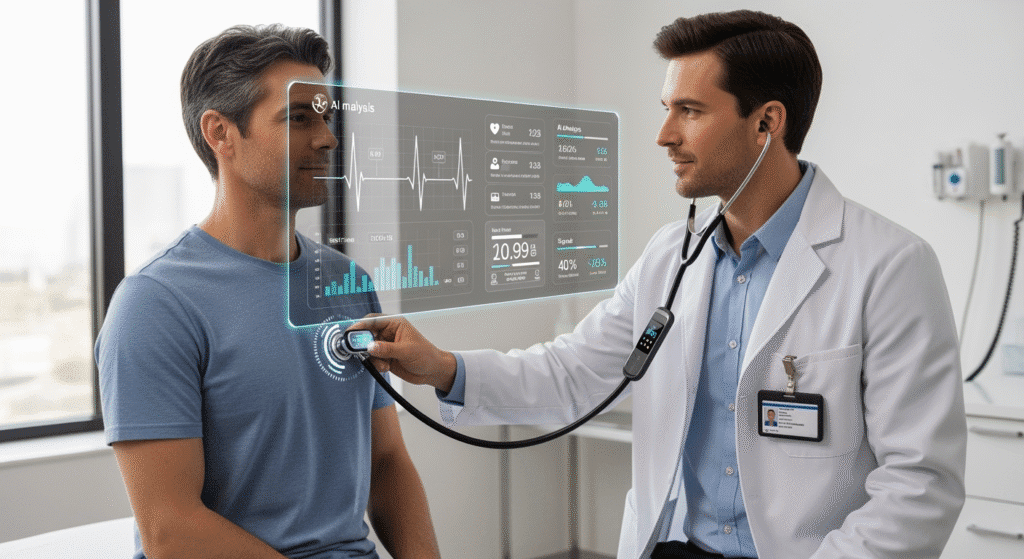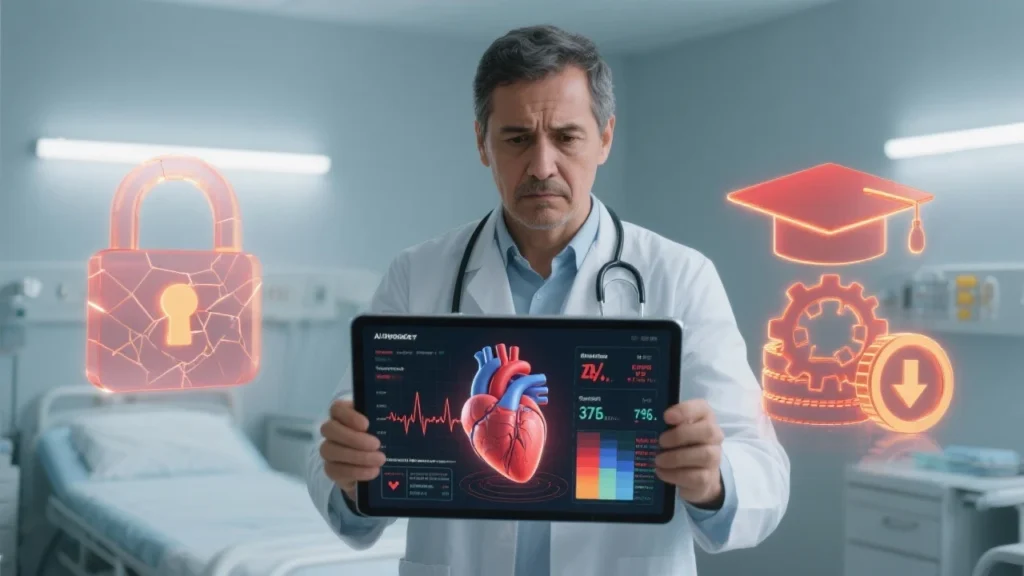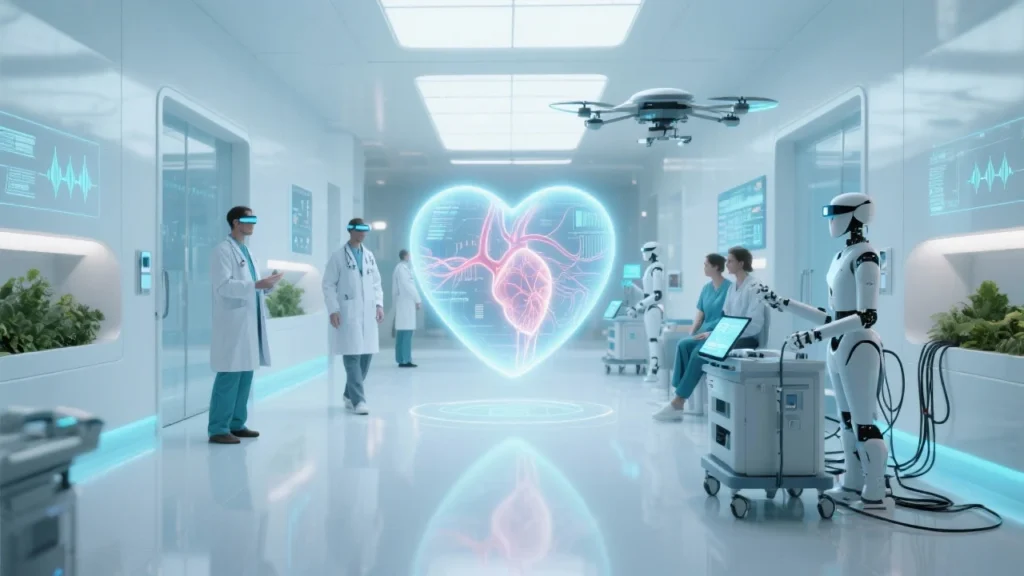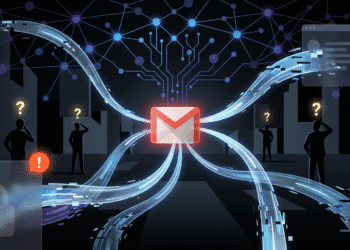The Stethoscope Enters a New Era

For over two centuries, the stethoscope has been a doctor’s trusted companion. Its simple design a chest piece, tubing, and earpieces has barely changed since René Laennec invented it in 1816. Now, a quiet revolution is underway. UK doctors have tested a next-generation stethoscope that uses artificial intelligence to detect heart conditions in just 15 seconds.
This isn’t just a gadget upgrade. It’s a breakthrough that could reshape how we diagnose one of the world’s leading killers cardiovascular disease.
Why This Matters
Heart disease remains the number one cause of death globally. According to the World Health Organization, it claims nearly 18 million lives each year. Early detection can mean the difference between a manageable condition and a fatal one. But spotting heart problems early has always been tricky. Traditional stethoscopes rely on the skill and experience of the physician. Subtle murmurs or irregular rhythms can go unnoticed.
That’s where artificial intelligence comes in.
The Technology Behind the Tool
The AI-powered stethoscope looks deceptively ordinary. A patient might not notice anything unusual as a doctor places it on the chest. What’s different happens inside. The device records heart sounds, then runs them through an AI algorithm trained on thousands of samples. Within 15 seconds, it can flag abnormalities such as arrhythmias, valve disorders, or signs of heart failure.
Doctors no longer rely solely on their ears. They now have a digital partner that enhances precision and reduces human error.
Accuracy That Rivals Hospital Tests
In trials across the UK, researchers compared the AI stethoscope’s performance with standard diagnostic tools like echocardiograms. The results were impressive. Accuracy rates matched or even exceeded those of hospital-based testing. What once required bulky machines and long waiting times can now be achieved in a doctor’s office or even a rural clinic with limited resources.
This speed and reliability could help unclog healthcare systems overwhelmed by long waiting lists and overbooked specialists.
A Game-Changer for Primary Care
Imagine this: a patient walks into a GP clinic complaining of mild chest discomfort. In the past, the doctor might schedule a referral, order tests, and wait weeks for results. With the AI stethoscope, the same patient could receive a near-instant preliminary diagnosis. If the device flags a risk, further tests can be fast-tracked. If not, unnecessary referrals can be avoided.
The ripple effect is huge. Patients get answers faster. Doctors make better decisions. Health services save money.
Not Just for Specialists
One of the most exciting aspects of the AI stethoscope is its accessibility. General practitioners, nurse practitioners, and even community health workers could use it effectively. The AI doesn’t get tired. It doesn’t miss a beat after a long shift. It brings the expertise of a cardiologist into settings where such expertise might not exist.
In parts of the world where cardiologists are scarce, this could revolutionize access to care.
The Human-AI Partnership
Some fear that artificial intelligence will replace doctors. The AI stethoscope tells a different story. It doesn’t make final decisions. Instead, it acts as an assistant highlighting patterns, suggesting possibilities, and giving doctors a clearer picture. Ultimately, the human clinician interprets the results and discusses them with the patient.
This partnership ensures that empathy, context, and medical judgment remain at the center of care.
A Look at Patient Reactions
For patients, the idea of an AI “listening” to their heartbeat might sound futuristic. Yet early feedback has been encouraging. Many find reassurance in knowing that their doctor is backed by advanced technology. The speed of results also reduces anxiety. No one likes waiting weeks to hear whether their heart is healthy or at risk.
The AI stethoscope delivers answers before the patient even leaves the room.
Challenges Ahead

Of course, no technology arrives without hurdles. Data privacy is a big concern. The device processes sensitive health information, and safeguards must ensure it isn’t misused. Training doctors and nurses to trust and interpret the AI results is another challenge. Healthcare systems are often slow to adopt new tools, especially those involving artificial intelligence.
Cost is also a factor. If the AI stethoscope is too expensive, its benefits might remain limited to well-funded hospitals. For it to make a global impact, affordability is crucial.
Global Implications
The potential extends far beyond the UK. In low-income countries, where access to advanced diagnostic machines is rare, AI stethoscopes could be lifesaving. They require little more than power and an internet connection for updates. Suddenly, rural clinics could deliver cardiology-level insights without sending patients hundreds of miles away.
If rolled out widely, this technology could help close the healthcare gap between rich and poor nations.
What Experts Are Saying
Cardiologists have cautiously praised the innovation. Many stress that while AI tools are promising, they must complement not replace established diagnostic methods. Early adopters in UK hospitals report that the AI stethoscope has already identified conditions that might otherwise have slipped through unnoticed.
Medical associations are watching closely. If larger studies confirm the early results, guidelines could soon recommend AI stethoscopes as standard equipment in clinics.
The Future of Diagnostic AI
This stethoscope is just the beginning. Experts envision a future where handheld devices powered by AI can scan for multiple conditions at once heart disease, lung issues, even neurological problems. The line between traditional tools and digital diagnostics is blurring fast.
For now, the humble stethoscope remains the symbol of medicine. But its AI-powered cousin may redefine that symbol for the 21st century.
Everyday Scenarios Transformed
Think about school health checks. Nurses could screen hundreds of children quickly, identifying those who need further testing. Sports teams could evaluate athletes’ heart health on the sidelines. Emergency responders could make faster decisions in ambulances.
These scenarios show how deeply this technology could embed itself into everyday life.
Balancing Hype with Reality
It’s easy to get carried away by the promise of new technology. AI stethoscopes are not magic wands. They won’t eliminate heart disease or replace comprehensive diagnostic tools. But they do offer a powerful new layer of safety and speed in detecting problems early.
As with all medical innovations, real-world data over time will determine their true value.
The Role of Regulation
For AI stethoscopes to become mainstream, regulatory approval is key. Agencies like the UK’s Medicines and Healthcare products Regulatory Agency (MHRA) and the US Food and Drug Administration (FDA) will need to evaluate safety and effectiveness. These processes take time, but they are essential for patient trust.
Once approved, insurance systems must also decide whether to cover the device. Without reimbursement, adoption could stall.
Training Tomorrow’s Doctors
Medical schools may soon need to update their curricula. Future doctors will not only learn how to listen with a stethoscope but also how to interpret AI-driven diagnostics. This blend of traditional and digital skills could become the new norm.
Some educators argue that it’s time for stethoscope training itself to evolve. Instead of teaching students to rely solely on their ears, why not pair training with AI feedback to accelerate learning?
Ethical Considerations
Beyond privacy, there’s the question of responsibility. If an AI stethoscope misses a diagnosis, who is accountable the doctor, the hospital, or the manufacturer? Clear legal and ethical frameworks must accompany the rollout.
There’s also the risk of over-reliance. If doctors grow too dependent on AI, their own diagnostic skills could weaken over time. Balancing trust in machines with human expertise will be critical.
Looking Ahead

The AI-powered stethoscope may feel like a small step just another tool in a doctor’s kit. But its implications are enormous. From saving lives through earlier detection to reshaping the way healthcare is delivered, this innovation is a glimpse into a future where technology and medicine beat in sync.
The next time you hear the word “stethoscope,” you might picture not just a doctor listening carefully, but also an AI quietly analyzing, ensuring no heartbeat goes unheard.
Sources
- Euronews – AI stethoscope can detect heart conditions in just 15 seconds, UK doctors find
- Medical Xpress – Humble stethoscope gets AI upgrade to detect heart conditions
- Digital Trends – AI-powered stethoscope promises heart disease detection in seconds
- WENews – AI-powered stethoscope could detect heart conditions within seconds









